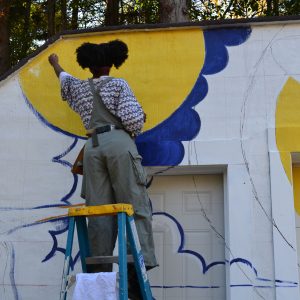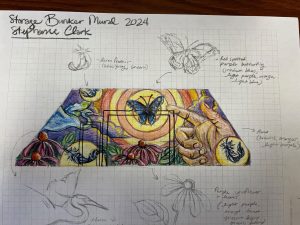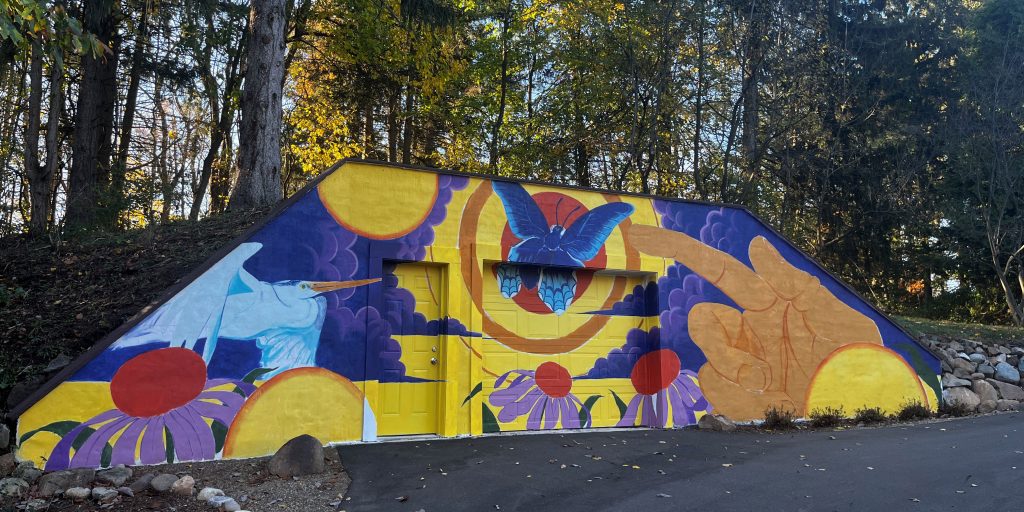
As I advanced toward the last year of my Ph.D. at the W.K. Kellogg Biological Station, the Kellogg Bird Sanctuary Grounds Manager, Lisa Duke, approached me about creating a mural on the property. The location was determined to be a blank wall that opened to an underground storage cellar near the entrance of the property. After recovering from the excitement and shock of this huge opportunity, I started brainstorming what could be painted on the wall.
As someone who studies the Cabbage White butterfly (Pieris rapae) and one of their host plants (in many cases: Brassica oleracea), I wanted butterflies and plants to be a part of whatever I created. After sketching several iterations of mural ideas, I incorporated elements from multiple sketches and chose to feature native Michigan organisms such as the Red Spotted Purple butterfly, Purple Coneflower, and a Great Blue Heron. I chose colors that would align with native prairie plants that will eventually be seeded around the storage cellar, and this palette later influenced the name of the mural itself.
Painting and Ph.D. work
Starting the mural was initially difficult, but I enjoyed every moment of it. This project coincided with the last experiment of my dissertation work, so I often did mural painting during the day, hung up my tool belt full of paint brushes at sunset, and went to the lab to care for my plants and caterpillars all evening. Special thanks to volunteer Al White and Avian Caretaker Brenden Kokx, who drew a 1-by-1 foot grid that helped me transfer my sketch to the wall.

On days where I painted after sunset, I would bundle up against the chilly fall air, turn my car’s headlights onto their brightest setting, set up two tiny battery-operated lights, and switch on my headlamp to keep working. Friends expressed concern that working at night in the dark forest would frighten them (and at some points I did spook myself), but painting to the squeaks of bats and night insects was uniquely soothing. Each hour that passed brought the painting to life bit by bit, and I witnessed the sun illuminate areas of the Sanctuary that I would never have noticed otherwise. On one particularly long painting night, I witnessed the aurora borealis waving in the north sky over the trees.
Lessons learned from weather and wildlife
Despite the utter tranquility of this project, there were multiple points in which I needed to problem-solve. For example, I left my original sketch on a clipboard in the cellar, and returned to an empty clipboard covered in mouse “decorations” the following day. This sketch is forever lost to time, but thankfully I had prepared multiple photocopies ahead of time. At another point close to the completion of the mural, rain came ahead of schedule nearly every day for a week right after I started working. This caused the paint to run significantly, and I spent many hours repainting rain damage. These unexpected trials emphasized the importance of preparedness, careful documentation, and being open to change.
While at first I was upset over alterations to my plans, the end of the project brought clarity that all I can do is adjust my plans accordingly to what I cannot control. Running paint was an opportunity for me to repaint an area even better than it was before, and mouse theft was an opportunity for me to enjoy the process rather than being attached to physical art. The goal of creating this mural was to encourage harmonious and positive interactions with nature, but this ended up being my own take-home message. I stopped being annoyed with the elements that controlled when and how much painting I could get done, and instead saw interruptions to my work as an opportunity to respect and acknowledge the ecosystem around me.
After roughly 104 hours of painting, more than 20 small tubs of paint, and the sacrifice of countless pencils and paint pens, the mural was complete. I will never forget this project and the lessons I learned from it. I intend to continue working on the intersection of art and science throughout my life, and I can’t wait to visit this mural many years into the future.

~~~~~~~~~~~~~~~~~~~~
Stephanie Clark is a Ph.D. student in the Haddad lab at the W.K. Kellogg Biological Station. She is a 2024 Science Outreach Fellow and studies the effects of climate change on butterflies and plants. Stephanie has been a lifelong artist and enjoys making nature-oriented paintings in her spare time.
~~~~~~~~~~~~~~~~~~~~

A legacy of conservation; a commitment to sustainability.
3700 E. Gull Lake Drive
Hickory Corners, MI 49060
(269) 671-5117
info@kbs.msu.edu